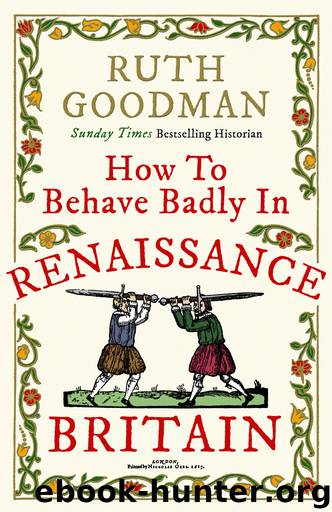How to Behave Badly in Renaissance Britain by Ruth Goodman

Author:Ruth Goodman [Goodman, Ruth]
Language: eng
Format: epub
Publisher: Michael O'Mara Books
All Tooled Up and Ready for Action
Learning to fight and handle weapons was part of most men’s youth at all levels of society, backed up by a patriotic and legal duty to do so. With no standing army to call upon, the defence of the realm was managed through a system of public duty. The aristocracy and gentry saw themselves, at least in part, as belonging to a form of elite warrior caste; their freedom from manual labour allowed them to concentrate upon martial prowess, and the potential for military service served as one justification for a lifestyle exempt from productive labour. Gentlemen, particularly second sons, were all potential professional soldiers and officers, should the need arise. Boys of this social group were expected and encouraged to be more combative than those of humble birth. Even in the advice literature that generally promoted self-control and restraint you find acknowledgement and support for this more aggressive outlook. ‘Be manly at neede, begin no quarrel in wrong,’ is Sir Hugh Rhodes’s admonition. While he didn’t approve of boys picking a fight, when provoked they should step up and ‘be manly’. His advice to young men in service to a lord includes the line, ‘Avoyde murther, save thyself, play the man being compelde’. Stout self-defence might well be an attribute that twenty-first-century men could reasonably advocate, but oh, what a different mindset it takes to include the injunction ‘avoid murdering anyone’ in a book of modern manners and conduct!
The common Renaissance man could also be called upon in times of crisis. His level of skill was necessarily curtailed by the little amount of training and practice that a life of labour permitted, but led by one of the gentlemanly officers, even the crudest of martial skills could be theoretically brought to bear at the monarch’s command. Under Henry VIII, every man from the age of six to seventy had a legal duty to practise with a bow and arrow upon a Sunday afternoon. Men, and those in authority over boys, were required to own the requisite equipment. The hope was that lifelong practice would develop bodies capable of making the bow into a formidable weapon of war. Most communities had areas set aside for the purpose – look out for street names such as ‘Butts Close’ for evidence of their whereabouts.
The Butts generally consisted of a raised earth bank upon which targets could be set up at the far end of a long enclosure, where men could perfect their aim as well as building the strength and technique required to shoot powerful bows at long distances. Pasture land near the edge of town frequently filled with men and boys on Sundays out enjoying a form of free-range archery known as ‘roving’. In small companionable groups they selected a mark, loosed their arrows at it and then ambled up to see whose arrow was closest before choosing the next mark. Rather like a round of golf but without the formal layout. Most men seem
Download
This site does not store any files on its server. We only index and link to content provided by other sites. Please contact the content providers to delete copyright contents if any and email us, we'll remove relevant links or contents immediately.
| Africa | Americas |
| Arctic & Antarctica | Asia |
| Australia & Oceania | Europe |
| Middle East | Russia |
| United States | World |
| Ancient Civilizations | Military |
| Historical Study & Educational Resources |
Underground: A Human History of the Worlds Beneath Our Feet by Will Hunt(12024)
Sapiens by Yuval Noah Harari(5294)
Navigation and Map Reading by K Andrew(5111)
The Sympathizer by Viet Thanh Nguyen(4305)
Barron's AP Biology by Goldberg M.S. Deborah T(4097)
5 Steps to a 5 AP U.S. History, 2010-2011 Edition (5 Steps to a 5 on the Advanced Placement Examinations Series) by Armstrong Stephen(3688)
Three Women by Lisa Taddeo(3354)
Water by Ian Miller(3127)
The Comedians: Drunks, Thieves, Scoundrels, and the History of American Comedy by Nesteroff Kliph(3039)
Drugs Unlimited by Mike Power(2545)
A Short History of Drunkenness by Forsyth Mark(2233)
DarkMarket by Misha Glenny(2158)
The House of Government by Slezkine Yuri(2158)
And the Band Played On by Randy Shilts(2129)
The Library Book by Susan Orlean(2042)
Revived (Cat Patrick) by Cat Patrick(1963)
The Woman Who Smashed Codes by Jason Fagone(1929)
Birth by Tina Cassidy(1864)
The Absolutely True Diary of a Part-Time Indian by Sherman Alexie(1858)
